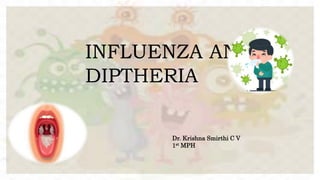
influeza and diptheria -Dr Krishna Smirthi CV.pptx
- 1. INFLUENZA AND DIPTHERIA Dr. Krishna Smirthi C V 1st MPH
- 2. INFLUENZA
- 3. Influenza is a communicable viral disease that affects the respiratory tract Head and body aches, sore throat, fever and respiratory symptoms, which can be severe WHO estimates that seasonal influenza may result in 290 000-650 000 deaths each year due to respiratory diseases alone INFLUENZA
- 4. HISTORY
- 6. SL.No Basis Type A Type B Type C 1 Symptoms Moderate to severe Mild Mild 2 Age Group All Primarily children All 3 Affect Humans and animal Affect human only Affects human only 4 Divided Subdivided based on antigenic differences Not divided into sub types Not divided into sub types 5 Epidemics Widespread Regional Don’t cause 6 Experienced Mostly Less comman than type A Rarely reported AGENT Family Orthomyxoviridae There are 3 viral subtypes, namely influenza type A, type B, and type C
- 7. RESERVOIR OF INFECTION It has become increasingly evident that a major reservoir of the influenza virus exists in animals and birds SOURCE OF INFECTION Case or subclinical case. PERIOD OF INFECTIVITY Virus is present in the nasopharynx from 1 to 2 days before and 1 to 2 days after onset of symptoms.
- 8. HOST FACTOR AGE AND GENDER: Influenza affects all ages and both sexes. HUMAN MOBILITY : Is considered as an important factor in the spread of infection. IMMUNITY : Antibodies appear in about 7 days after the attack and reach a maximum level in about 2 weeks. After 8 to 12 months, the antibody level drops to a pre-infection level
- 9. Mode of transmission Person to person by droplet infection created by sneezing, coughing, or talking. The portal of entry of the virus is the respiratory tract. Incubation period 18 to 72 hours. Season Winter months or rainy season Overcrowding ENVIRONMENTAL FACTORS
- 10. Virus The respiratory tract inflammation and necrosis of superficial epithelium of the tracheal and bronchial mucosa PATHOGENESIS INFLUENZA
- 11. PANDEMIC INFLUENZA A (H1N1) 2009 (SWINE FLU)
- 12. Good ventilation of public buildings Avoidance of crowded places Cover their face Isolation Vaccination PREVENTION OF INFLUENZA LABORATORY DIAGNOSIS *Virus isolation *Serology *Elisa
- 13. As of 2016, the World Health Organization (WHO) recommends seasonal influenza vaccination for: First priority: •Pregnant women Second priority (in no particular order): •Children aged 6–59 months •Elderly •Individuals with specific chronic medical conditions •Health-care workers Trivalent vaccine The trivalent vaccine protects against three strains of the flu; these include two strains of influenza A and one of influenza B INFLUENZA VACCINE
- 14. New versions of the vaccines are developed twice a year, as the influenza virus rapidly changes Killed vaccines Most influenza vaccination programs make use of inactivated vaccines Subcutaneous route . Dose of 0.5 ml for adults and children over 3 years. 0.25 ml for children from 6 months to 36 months of age Live attenuated vaccines The live, weakened vaccine is generally not recommended in pregnant women, children less than two years old, adults older than 50, or people with a weakened immune system. Depending on the type they can be injected into a muscle, sprayed into the nose, or injected into the middle layer of the skin (intradermal) INFLUENZA VACCINE
- 15. Treatment Symptomatic care Antiviral Therapy : Oseltamivir phosphate,Zanamivir Chemoprophylaxis
- 16. GISRS In 1947, WHO’s Interim Committee recognized the importance of Influenza and started a globally- coordinated effort for its surveillance, study and control. This led to the beginning of the Global Influenza Programme (GIP) and the Global Influenza Surveillance and Response System (GISRS)
- 17. Acute infectious disease caused by toxigenic strains of Corynebacterium diphtheriae 3 major clinical types anterior nasal, faucial, laryngeal Skin,conjunctiva, vulva and other parts may be affected DIPTHERIA
- 18. HISTORY
- 21. Agent factors AGENT: Corynebacterium diphtheriae SOURCE OF INFECTION: The source of infection may be a case or carrier INFECTIVE MATERIAL: Nasopharyngeal secretions, discharges from skin lesions, and possibly infected dust. PERIOD OF INFECTIVITY: Unless treated, the period of infectivity may vary from 14 to 28 days from the onset of the disease, but carriers may remain infective for much longer periods AGE : 1 to 5 SEX : Both sexes are affected. IMMUNITY : Infants born of immune mothers are relatively immune during the first few weeks or months of life Host factors
- 22. Cases of diphtheria occur in all seasons, although winter months favour its spread. Environmental factors Mode of transmission Droplets infections Infected cutaneous lesions Contaminated object Respiratory route Non-respiratory routes Portal of entry Incubation period 2 to 6 days, occasionally longer. Incubation period
- 23. Anterior nasal A white membrane usually forms on the nasal septum Laryngeal diphtheria can be either an extension of the pharyngeal form or can involve only this site. Faucial diphtheria The infection is limited mostly to the tonsillar region; Cutaneous diphtheria Skin infections may be manifested by a scaling rash or by ulcers Diphtheria Clinical type
- 24. •A thick, gray membrane covering the throat and tonsils A sore throat& hoarseness Swollen glands in the neck (Bull’s neck) Difficulty breathing Fever and chills Difficulty swallow Diagnosis Clinical feature with detection of pseudo membrane Albert staining for oropharynx and larynx Sign and Symptoms
- 26. Prevention Early detection Isolation Imminization
- 27. Immunization Combined or mixed vaccine: Pentavalent vaccine DPT (Diptheria-pertussis-tetanus) DT (Diphtheria-tetanus toxoid) DT (Diptheria-tetanus, adult type) Single vaccines: FT (formal-toxoid). APT (alum-precipitated toxoid) PTAP (purified toxoid aluminium phosphate) PTAH (purified toxoid aluminium hydroxide) TAF (toxoid-antitoxin floccules) Antisera:1. Diphtheria anti-toxin Diphtheria vaccine
- 28. DPT Vaccine Content- Diptheria, Pertussis and Tetanus toxoid Route – Deep intramuscular part of thigh Dose – 0.5ml Recommended site – Anterolateral part of thigh DTP vaccine – Schedule 1. 1st dose - 6th week. 2. 2nd dose – 10th week. 3. 3rd dose – 14th week.—4. 4. 1st booster – 18-24 months. 5. 2nd booster – 4-5 years. Diphtheria vaccine